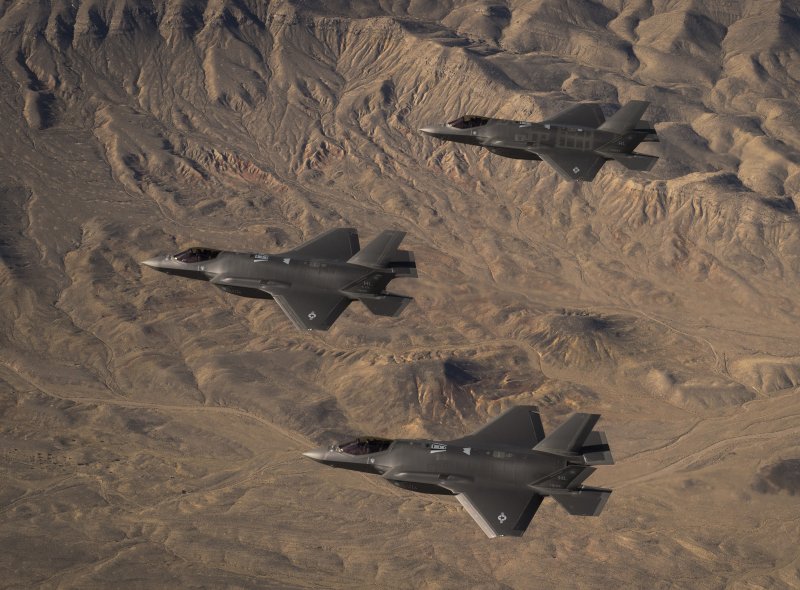Three U.S. Air Force F-35A Lightning IIs, assigned to the 4th Fighter Squadron from Hill Air Force Base, Utah, conduct flight training operations over the Utah Test and Training Range. Photo by Staff Sgt. Andrew Lee/U.S. Air Force
Nov. 6 (UPI) -- The U.S. Air Force's 388th Fighter Wing's 4th Fighter Squadron and 4th Aircraft Maintenance Unit recently conducted combat exercises testing and evaluating their ability to operate the F-35A Lightning II under high-tempo deployment conditions.
The F-35 Lightning II Joint Strike Fighter is a 5th generation multi-role stealth platform expected to replace most of the U.S. military fighter fleets and supplement other platforms.
Over 320 aircraft have been delivered to the U.S. and partner nations, with more than 680 pilots and 6,200 maintenance crewmen trained or in training. Long-term production plans call for several thousand planes to be built for the U.S. military and approved foreign buyers.
The aircraft are currently, in both the United States and allied militaries, slowly being made operational and put through exercises as pilots and maintenance crews get familiar with the aircraft.
While questions remain about the aircraft -- including an issue with fuel tubes that led to the worldwide fleet of F-35s being grounded for a couple of days last month -- many countries, including the United States, are using them in operations now.
"Aircraft deployed are ready for combat," Joe DellaVedova, spokesman for the F-35 Joint Program Office, told UPI.
The F-35A, flown by the Air Force, and F-35B, the vertical takeoff and landing variant used by the Marine Corps, have already reached initial operational capability. Several U.S. squadrons are deployed abroad on the USS Wasp and USS Essex amphibious assault carriers, Japan and the Middle East.
The Navy's F-35C, designed for large Nimitz-class and Ford-class fleet carriers, is expected to become fully operational sometime next year, DellaVedova said.
The recent Air Force exercises, flown from Hill Air Force Base, focused on combat operations and tactical scenarios, including damage to aircraft from enemy fire, pilot recovery following ejection or ditching and flying in an environment with restricted or non-existent communications.
The exercise involved close to 150 flights in two weeks, in addition to normal scheduled flights, over the Utah Test and Training Range.
"The tempo gives our Airmen a taste of deployed operations," 4th FS commander Lt. Col. Yosef Morris said in a press release. "We want the first time they see these things to be in a training environment, and not when we're called upon to deploy during a contingency."
Pilots flew with standard combat gear not normally worn during routine training operations such as side arms. Ground crews trained with loading weapons and other equipment onto the aircraft over longer shifts that included night operations.
The squadron and ground units also practiced launches from alternate airfields and operations from a secured deployable facility. The ground installation includes mission planning, debriefs, intelligence gathering and the Autonomic Logistics Information System.
ALIS is the F-35's internal diagnostic system designed to facilitate maintenance requirements and automatically transfer work and part orders to a database to ease logistical burdens. ALIS has experienced a number of software, firmware and hardware problems over the course of it's development, with some glitches still to be ironed out, according to the Air Force.
"This was a big planning and execution effort for the 4th FS and 4th AMU," said 1st Lst. Eric Dolan, officer in charge of the 4th AMU. "It was designed to challenge us and provide our Airmen with experience and acclimate our new Airmen. They came away more confident in their abilities."
A Marine Corps F-35B in September conducted a ground clearance strike mission in Afghanistan, marking the first combat use of the F-35 in U.S. service.
The aircraft has also been operated by Israel over Syria and Lebanon with the scope or number of flights unclear. Several nations including Norway, Italy and Australia are actively training with their F-35's, with the United Kingdom working to integrate the plane with their Queen Elizabeth-class aircraft carrier.
The F-35A used in the Air Force exercise is the standard land-based variant, and allows for greater maneuverability then the B and C variants.
Procurement costs of each A model have been steadily dropping as production ramps up with a cost per plane of $89.2 million. The F-35B is currently expected to cost $115.5 million each and the F-35C comes in at $107.7 million, according to Lockheed Martin, the manufacturer of the aircraft.
The F-35 is the most expensive weapons program in U.S. history with total costs estimated to total $1.4 trillion over the anticipated life of the plane.














